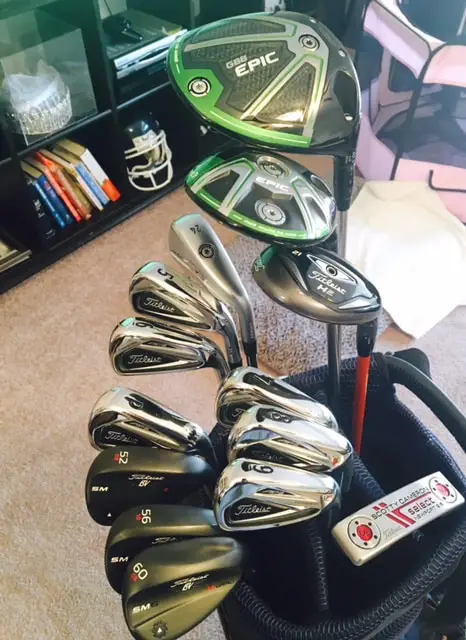What is a Mid-Handicapper

Golf is a game that embraces players of all skill levels, providing an equal opportunity for enjoyment and competition. Within the world of golf, handicaps play a significant role in leveling the playing field, allowing golfers of different abilities to compete against each other. One specific skill level that holds its own unique place is that of the mid-handicapper.
A mid-handicapper is a golfer who has progressed beyond the beginner stage and has achieved a moderate level of proficiency in the game. They have surpassed the initial learning curve and developed a solid foundation of golfing skills. However, they still strive to improve their game and achieve lower handicaps.
In this article, we will delve into the concept of a mid-handicapper, exploring their characteristics, challenges they face, strategies to enhance their skills, and equipment considerations. Whether you consider yourself a mid-handicapper or are simply curious about this skill level, this guide will provide valuable insights into the world of golf at the mid-handicap range.
Join us as we explore the journey of the mid-handicapper, understanding their aspirations, embracing their challenges, and discovering the paths to improvement. Whether you’re looking to enhance your own game or gain a deeper understanding of golf’s diverse skill levels, this article will serve as a comprehensive resource. So, let’s tee off and dive into the realm of the mid-handicapper in the captivating world of golf.

Understanding Golf Handicaps
Before we delve into the specifics of mid-handicappers, let’s first understand the concept of golf handicaps. Golf handicaps are numerical representations of a golfer’s ability and are calculated based on their scores in previous rounds. The purpose of a handicap is to level the playing field, allowing golfers of different skill levels to compete on an equal footing. The lower the handicap, the better the golfer’s skill level.
Handicaps are determined using a formula that takes into account a player’s scores, the course rating, and the slope rating of the course they play. This formula results in a handicap index, which is used to adjust a golfer’s score in relation to the difficulty of the course they are playing.
The Mid-Handicapper: Definition and Characteristics
Now let’s dive into the main topic: the mid-handicapper. A mid-handicapper falls within a specific handicap range that typically ranges from 10 to 20. However, it’s important to note that the exact range can vary depending on the golf association or region. Mid-handicappers are often considered to be intermediate-level golfers who have progressed beyond the beginner stage but are still working towards achieving lower handicaps.
Skill Level and Scoring Expectations
Mid-handicappers have developed a certain level of proficiency in the game. They possess a solid foundation of golfing skills and are capable of hitting consistent shots. However, they may still struggle with certain aspects of their game, leading to occasional inconsistencies in their scores. The goal for mid-handicappers is to continue improving their skills to lower their handicap and achieve more consistent scores.
Consistency and Improvement Goals
One of the key characteristics of mid-handicappers is their desire for improvement. They understand the importance of consistent performance and strive to refine their skills to achieve better scores. Mid-handicappers often focus on identifying areas of their game that require improvement and work diligently to address those weaknesses. By focusing on both the strengths and weaknesses of their game, mid-handicappers aim to achieve greater consistency and overall improvement.
Balanced Mix of Strengths and Weaknesses
Mid-handicappers have developed a well-rounded game with a balance of strengths and weaknesses. They are typically proficient in certain aspects of the game, such as driving off the tee or their short game, while still working on other areas to refine their skills. It is common for mid-handicappers to seek ways to improve their weaker areas, whether it’s by practicing specific shots, seeking professional instruction, or analyzing their performance to identify areas for growth.
Challenges Faced by Mid-Handicappers
While mid-handicappers have achieved a commendable level of skill, they still encounter challenges that impede their progress towards lower handicaps. Understanding and addressing these challenges is key to overcoming them and continuing the journey of improvement. Let’s explore some of the common challenges faced by mid-handicappers:
Striving to Break Through Scoring Barriers
Mid-handicappers often find themselves trying to break through scoring barriers to achieve lower handicaps. It can be frustrating to consistently score in a certain range without seeing significant progress. However, by identifying specific areas of their game that are holding them back and implementing targeted practice and improvement strategies, mid-handicappers can work towards breaking through these barriers and achieving lower scores.
Difficulty in Consistently Achieving Lower Scores
Achieving consistency in scoring is a challenge for mid-handicappers. While they may have the ability to produce excellent shots and achieve low scores on occasion, maintaining that level of performance consistently can be elusive. Mid-handicappers often face fluctuations in their game, resulting in variations in their scores. Developing mental resilience, focusing on course management, and refining their shot selection can help mid-handicappers maintain consistency in their game and achieve more desirable scores.
Balancing Strengths and Weaknesses for Consistent Performance
Mid-handicappers must navigate the delicate balance between leveraging their strengths and addressing their weaknesses. While capitalizing on their strengths can lead to impressive shots and scores, neglecting their weaknesses can hinder overall performance. Mid-handicappers should focus on developing a well-rounded game by dedicating time and effort to improving weaker areas. By striking a balance between their strengths and weaknesses, mid-handicappers can achieve more consistent performance on the course.
In the next sections, we will discuss various strategies that mid-handicappers can employ to improve their game, overcome these challenges, and continue their journey towards becoming lower handicappers.
Strategies for Mid-Handicappers to Improve Their Game
Mid-handicappers are constantly seeking ways to improve their skills and progress towards lower handicaps. Fortunately, there are several effective strategies they can employ to enhance their game. Here are some practical tips and techniques for mid-handicappers:
1. Practice Routines for Honing Specific Skills
Developing a structured practice routine is essential for mid-handicappers looking to improve their game. By focusing on specific skills during practice sessions, such as putting, chipping, or driving, mid-handicappers can target areas that require improvement. Additionally, practicing different scenarios, such as challenging lies or shots from uneven terrain, can enhance versatility and problem-solving skills on the course.
2. Seeking Professional Instruction and Guidance
Working with a golf instructor or coach can provide invaluable guidance for mid-handicappers. A golf professional can assess a mid-handicapper’s swing mechanics, provide feedback, and suggest specific drills or exercises to address areas of improvement. Professional instruction helps mid-handicappers refine their technique, optimize their swing, and enhance overall performance.
3. Mental Game Strategies and Course Management Techniques
The mental aspect of the game is crucial for mid-handicappers. Developing mental fortitude, maintaining focus, and managing emotions on the course can significantly impact performance. Mid-handicappers should explore mental game strategies such as visualization, positive self-talk, and pre-shot routines to improve focus and maintain a confident mindset. Additionally, learning effective course management techniques, such as shot selection and risk assessment, can help mid-handicappers navigate the course strategically and make informed decisions that lead to better outcomes.
Remember, consistency and improvement require dedication, practice, and a growth mindset. Mid-handicappers should approach their journey with patience and a willingness to learn, knowing that progress will come with time and effort.
Equipment Considerations for Mid-Handicappers
Selecting the right equipment is important for mid-handicappers to optimize their performance and enhance their overall game. Here are some key equipment considerations for mid-handicappers:
Club Fitting and Customization Options
Club fitting is crucial for mid-handicappers to ensure that their clubs are suited to their swing characteristics and body measurements. A professional club fitting session can help determine the optimal shaft flex, clubhead design, and club length for a mid-handicapper’s swing. Customization options, such as adjusting loft and lie angles, can further fine-tune clubs to match a mid-handicapper’s specific needs.
Balance of Forgiveness and Workability in Club Design
Mid-handicappers can benefit from a balance of forgiveness and workability in their club selection. Forgiving clubs, with features such as perimeter weighting and larger sweet spots, can help mitigate the impact of off-center hits and provide more consistent distances. At the same time, mid-handicappers should seek clubs that offer a level of workability, allowing them to shape shots and exercise greater control when needed.
Importance of Proper Shaft Flex and Clubhead Technology
The shaft flex of golf clubs plays a vital role in optimizing performance for mid-handicappers. The appropriate shaft flex can contribute to a more consistent ball flight and help generate the desired distance and accuracy. Mid-handicappers should also consider the advancements in clubhead technology, such as improved face technologies and weight distribution, which can enhance forgiveness and playability.
By carefully considering these equipment factors, mid-handicappers can ensure they have the tools necessary to support their game and maximize their potential on the course.
In conclusion, being a mid-handicapper signifies a level of proficiency and dedication to the game of golf. While mid-handicappers face challenges, they also have the opportunity to continue improving their skills and working towards lower handicaps. By employing strategies such as focused practice, seeking professional guidance, and refining their mental game, mid-handicappers can overcome challenges and unlock their full potential on the course. Additionally, considering equipment considerations tailored to their needs can further enhance their performance. So, embrace your status as a mid-handicapper, embrace the journey of improvement, and enjoy the game to the fullest!




